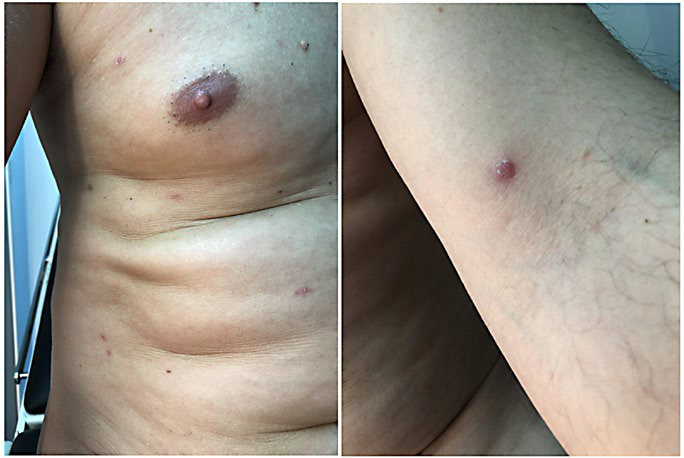INTRODUCTION
Diagnosis of syphilis remains a major challenge due to its multiple clinical presentations, and confirmation of diagnosis is still based mostly on serological testing, although several limitations have been described. Prozone phenomenon is responsible for false negative non-treponemal syphilis testing, which can be more frequent in cases with HIV/ syphilis coinfection.1 In patients with a history of syphilis in the past, the diagnosis of syphilis reinfection is difficult if prozone phenomenon occurs.
CASE REPORT
A 46-year-old male patient, MSM (man who has sex with man) was referred to our department due to balanitis present for 4 weeks. The patient had HIV-1 infection diagnosed in 2010, with good adherence to HAART (highly active antiretroviral therapy) and >600 CD4+ cells/μL and na undetectable viral load at the examination. He also had a history of latent syphilis in 2009, with the last serologic test reactive for TPPA (Treponema pallidum particle agglutination assay) 1 year before. He also suffered from recurrent genital herpes for 10 years. The patient reported only one sexual partner in the last year and his last sexual encounter was 3 months ago.
Physical examination revealed balanoposthitis with na erythematous eroded plaque on the balanopreputial sulcus, with a firm base on palpation, consistent with the syphilitic balanitis of Follmann (Fig. 1), associated with a painless unilateral inguinal lymphadenopathy.
A thorough examination also revealed asymptomatic erythematous papules and nodules with slight scaling, dispersed through the trunk, upper arms, forehead and right foot (Fig.s 2a and 2b), that appeared after the genital lesion.
He also referred headache, muscle pain, and fatigue, that faded away without treatment. He had no lesions on the oral mucosa or perianal region.
At the time of the consultation, he had a reactive TPPA and negative VDRL, and PCR (polymerase chain reaction) testing performed on the eroded penis lesion was negative for Treponema pallidum and herpes simplex virus type 1 and 2. Despite these laboratorial findings, as there was a high clinical suspicion of syphilis, it was decided to repeat the serological tests for syphilis, to complete the screening for sexually transmitted infections, perform a lesional biopsy and a new genital scraping for PCR testing and initiate immediately treatment with long acting benzathine penicillin G (three doses of 2.4 million units intramuscular each at 1-week intervals).
Serological tests for syphilis revealed a positive VDRL (1:32), but PCR testing was again negative for T. pallidum. The screening for other sexually transmitted infections was negative. Histopathology showed a lymphoplasmocytic mononuclear inflammatory infiltrate in the dermis, supporting the clinical diagnosis of syphilis. A week after treatment the patient was feeling better with disappearance of almost all the lesions, and clearance was complete at 4 weeks.
CONCLUSION
This case reports a patient with syphilis reinfection presenting as a syphilitic balanitis of Follmann and syphilides on the trunk and limbs and a negative VDRL as a “prozone phenomenon”. The patient had a past history of syphilis, so a reactive TPPA test was expected. Actually, treponemal tests fail to distinguish treated syphilis from active/latent syphilis.
Prozone phenomenon is an immunological phenomenon responsible for false negative non-treponemal tests, such as VDRL. It occurs when there are extremely high levels of antibodies in patients with syphilis, which interfere with the formation of that lattice of antigen-antibody complexes necessary for visualization of flocculation,2 precipitation or agglutination. Reaction will be positive when the optimal ratio of antigen to antibody yields an insoluble precipitate.3 The zone of equivalence defines this optimal ratio. In the zone of antibody excess (prozone) or antigen excess (postzone), false negative results may occur.4
The incidence of prozone phenomenon is estimated to be 0.2% - 2%,5 but it may be higher in HIV-positive population due to B-cell dysregulation leading to hyper-responsiveness to antigen stimulation and greater antibody production.6
Concerning syphilitic balanitis of Follmann, it is considered a very uncommon condition, given that the incidence of balanitis in cases of primary syphilis is reported to be 0.3% - 0.5%.7 Up to now, less than 100 cases has been described in literature and it remains unknown if it is more frequent in high risk groups, such as MSM and/or HIV-positive patients.8
PCR is a fast and efficient test for the detection of T. pallidum mostly in primary genital or anal chancres. In our case the PCR testing for T. pallidum was negative but this result must not exclude the diagnosis of syphilis. Actually, T. pallidum
PCR seems to be more efficient to confirm than to exclude syphilis diagnosis.9
This case reminds that syphilis is, in fact, the great imitator, due to its clinical polymorphism, raising several differential diagnoses. Since prozone phenomenon may occur with tests frequently used for laboratory diagnosis of syphilis, it further increases the clinical challenge.
As T. pallidum specific serology generally remains reactive for life, the diagnosis of syphilis reinfection relies on clinical assessment and non-treponemal serologic testing.10
Given this, it is important that clinicians maintain a high index of suspicion, to consider this phenomenon in patients with clinical signs suggestive of syphilis, when the non-treponemal tests are negative.
Learning points
Syphilis diagnosis remains a major challenge and a complex diagnosis. Although several limitations have been described, serological testing remain the leading method for syphilis diagnosis.
Prozone phenomenon represents a false negativity of non-treponemal tests, such as VDRL, which occurs when there are extremely high levels of antibodies in patients with syphilis.

















